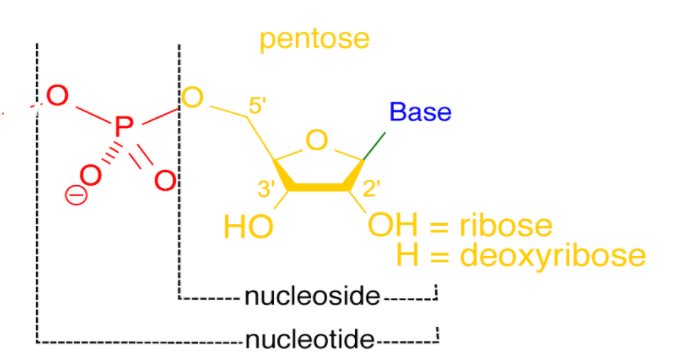
Nucleoside is a nucleotide without
a. Sugar
b. Nitrogen base
c. Hydrogen bond
d. Phosphate group
Answer
578.1k+ views
Hint: A nucleoside consists simply of a nitrogenous base and a five-carbon sugar (either ribose or deoxyribose), whereas a nucleotide is composed of a nitrogenous base, a five-carbon sugar (ribose or deoxyribose), and one or more phosphate groups.
Complete answer:
The nucleic acid is a genetic material that takes part in the inheritance of genetic material present in the nucleus of a cell. It is made up of the three important components namely nitrogenous bases, sugar and phosphate.
These three components are collectively known as a “nucleotide“. A long chain of different nucleotides form a polynucleotide chain which leads to formation of a DNA molecule. The sugar present in it is either ribose or deoxyribose that makes up RNA or DNA, respectively. Nucleotides are named based on the number of phosphate groups they have. For example, a nucleotide that contains an adenine base and three phosphate groups would be named adenosine triphosphate (ATP). If the nucleotide has two phosphates, it would be adenosine diphosphate (ADP) and if there is only one phosphate, the nucleotide is adenosine monophosphate (AMP).
The nucleosides are only made up of nitrogenous bases and sugar. A nucleoside is obtained from the hydrolysis of nucleotides. Examples of nucleosides include adenosine, cytidine, uridine, guanosine, thymidine, etc. However, a nucleoside is insignificant for a cell and doesn’t involve the construction of DNA.
On the other hand, by the process of phosphorylation, using the enzyme kinase, a phosphate group is attached to the sugar of the nucleic acid and constructs the nucleotide.
Therefore, through the process of hydrolysis, the nucleotides are converted into nucleosides while through the phosphorylation, the nucleosides are converted into nucleotides.

Nucleoside = Sugar + Base
Nucleotide = Sugar + Base + Phosphate
Hence, The correct answer is option (D).
Note: Nucleotides belong to the class of organic compounds in which the molecular structure comprises a nitrogenous base (nitrogen-containing base) linked to a sugar molecule and a phosphate group. Nucleotides without the phosphate group are called nucleosides.
Complete answer:
The nucleic acid is a genetic material that takes part in the inheritance of genetic material present in the nucleus of a cell. It is made up of the three important components namely nitrogenous bases, sugar and phosphate.
These three components are collectively known as a “nucleotide“. A long chain of different nucleotides form a polynucleotide chain which leads to formation of a DNA molecule. The sugar present in it is either ribose or deoxyribose that makes up RNA or DNA, respectively. Nucleotides are named based on the number of phosphate groups they have. For example, a nucleotide that contains an adenine base and three phosphate groups would be named adenosine triphosphate (ATP). If the nucleotide has two phosphates, it would be adenosine diphosphate (ADP) and if there is only one phosphate, the nucleotide is adenosine monophosphate (AMP).
The nucleosides are only made up of nitrogenous bases and sugar. A nucleoside is obtained from the hydrolysis of nucleotides. Examples of nucleosides include adenosine, cytidine, uridine, guanosine, thymidine, etc. However, a nucleoside is insignificant for a cell and doesn’t involve the construction of DNA.
On the other hand, by the process of phosphorylation, using the enzyme kinase, a phosphate group is attached to the sugar of the nucleic acid and constructs the nucleotide.
Therefore, through the process of hydrolysis, the nucleotides are converted into nucleosides while through the phosphorylation, the nucleosides are converted into nucleotides.

Nucleoside = Sugar + Base
Nucleotide = Sugar + Base + Phosphate
Hence, The correct answer is option (D).
Note: Nucleotides belong to the class of organic compounds in which the molecular structure comprises a nitrogenous base (nitrogen-containing base) linked to a sugar molecule and a phosphate group. Nucleotides without the phosphate group are called nucleosides.
Recently Updated Pages
Master Class 12 Business Studies: Engaging Questions & Answers for Success

Master Class 12 Economics: Engaging Questions & Answers for Success

Master Class 12 English: Engaging Questions & Answers for Success

Master Class 12 Maths: Engaging Questions & Answers for Success

Master Class 12 Social Science: Engaging Questions & Answers for Success

Master Class 12 Chemistry: Engaging Questions & Answers for Success

Trending doubts
What are the major means of transport Explain each class 12 social science CBSE

Which are the Top 10 Largest Countries of the World?

Draw a labelled sketch of the human eye class 12 physics CBSE

Explain sex determination in humans with line diag class 12 biology CBSE

The pH of the pancreatic juice is A 64 B 86 C 120 D class 12 biology CBSE

Give 10 examples of unisexual and bisexual flowers




